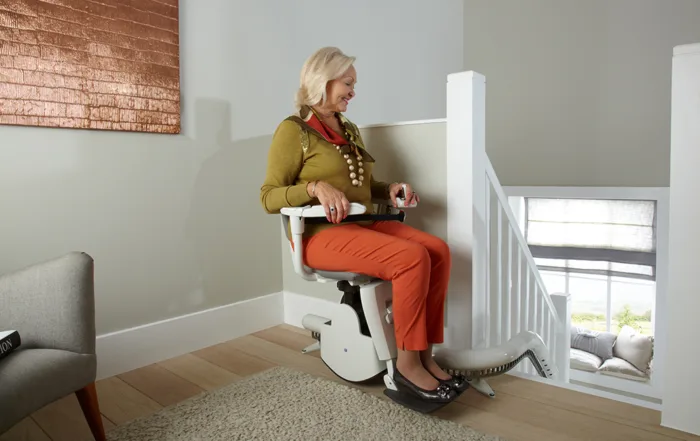How to Approach the Topic of Home Adaptations Gently
Categories:
Blog , Helpful Hints
Date Posted:
April 17, 2024

In our lives, there comes a time when we may need to broach sensitive subjects with our loved ones, particularly when it concerns their independence and safety. Discussing the need for home adaptations such as stairlifts, lifts, ramps, and other mobility aids can be challenging. It’s crucial to handle these conversations with compassion and understanding. Here are some strategies to help you approach the topic gently and effectively.
How to start the conversation
- Start with Empathy
Empathy is the cornerstone of any sensitive conversation. Before initiating the discussion, put yourself in your loved one’s shoes. Understand that accepting help or adapting the home may feel like a loss of independence to them. Acknowledge their feelings and reassure them that the goal is to enhance their independence, not diminish it. - Choose the Right Time and Setting
Timing and environment play critical roles in how well your message is received. Choose a quiet, private setting where you can talk without interruptions. Ensure it’s a time when your loved one feels relaxed and open to conversation. Avoid times of stress or fatigue. - Educate and Inform
Lack of information can sometimes lead to resistance. Educate your loved one about the various options for home adaptations. Highlight how mobility solutions like stairlifts or ramps are designed to blend seamlessly into their home and lifestyle. Share stories or testimonials from people who have regained independence through similar adaptations. - Listen Actively
Be an active listener. Allow your loved one to express their concerns and feelings about home adaptations. Show that you are listening by nodding, maintaining eye contact, and responding appropriately to their worries. Validate their emotions and show that their opinions are important in making the final decision. - Involve Them in the Decision-Making Process
Involve your loved one in every step of the decision-making process. Let them feel they have control over the choices made about their mobility and home layout. For instance, take them along to see different models of stairlifts or have them meet with consultants. This inclusion can make the transition much smoother. - Highlight the Benefits
Focus on the positive aspects of what home adaptations can bring. Emphasize the safety features, the increased accessibility, and the potential for a better quality of life. Discuss how these changes will allow them to continue enjoying their home comfortably and safely. - Be Patient and Give Space
After your discussion, give your loved one some time to think about their options. They may need space to process the information and come to terms with the need for adaptations. Be patient and let them know you are available whenever they are ready to discuss further or make decisions. - Offer Reassurance
Throughout the conversation, reassure your loved one that your primary concern is their well-being and happiness. Let them know that you and other family members are supportive and that the goal is to ensure they can lead a fulfilling life with as much independence as possible.
Approaching the topic of home adaptations can be delicate, but with empathy, understanding, and proper communication, you can help your loved one see the benefits of such changes. Remember, the goal is to enable them to live safely and comfortably in their own homes. By taking a gentle approach, you can help facilitate a positive outcome that supports their independence and quality of life.
At EMS, our surveyors are trained to handle these situations with compassion and understanding, they have a wealth of knowledge about our product range to clearly explain the options available and the benefits that they’ll offer to your loved one. We also have a large showroom in Baldock, Hertfordshire, where you can come and explore our offering and ‘try-before-you-buy’. This is a great option for loved ones who are apprehensive about the purchase as we can alleviate their worries with a demonstration of the product.
Our friendly team are on hand and happy to chat through all of the options, contact us here.
Frequently Asked Questions
Q: What specific types of home adaptations are available for improving mobility at home?
A: There are several types of home adaptations to improve mobility, including stairlifts, ramps, widened doorways, and bathroom modifications like walk-in showers and grab bars. Each option is designed to cater to specific needs and can significantly enhance independence and safety in the home.
Q: How do I find the right professionals to handle the installation of home adaptations?
A: It’s important to choose professionals who are experienced in home adaptations for increased mobility. You can start by consulting with healthcare providers for recommendations or searching for certified contractors who specialise in home modifications for accessibility. Always check for reviews and previous work to ensure quality and reliability.
Q: Are there financial aid programs available to help cover the cost of these adaptations?
A: Yes, there are several financial aid programs available to help with the costs of home adaptations. This can include grants from local government bodies, charities focused on disability support, and sometimes insurance coverage depending on the circumstances and the type of adaptation required.
Q: How long does it typically take to install common adaptations like ramps or stairlifts?
A: The installation time can vary depending on the complexity of the adaptation. For simpler installations like ramps, the process may take a few hours to a day. More complex adaptations such as stairlifts might require a few days to ensure they are fitted properly and safely.
Q: What are some common concerns or objections from loved ones about home adaptations, and how can I address them effectively?
A: Common concerns include fears about losing independence, the cost of adaptations, and the aesthetic impact on their home. Address these concerns by emphasising the benefits of enhanced safety and independence, discussing financial aid options, and showing how adaptations can be designed to blend seamlessly with their home environment.






